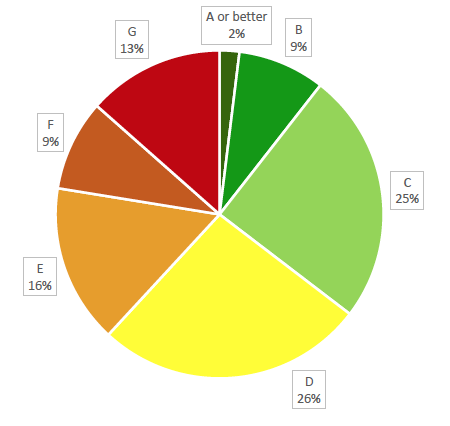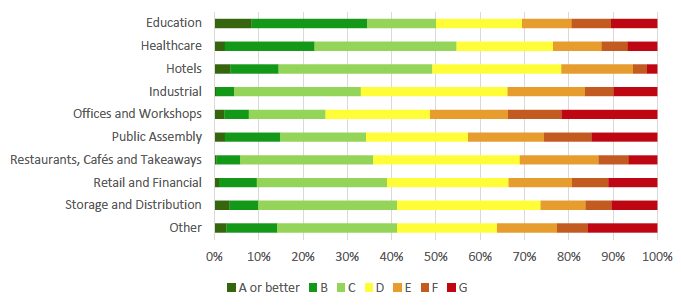Scotland's non-domestic energy efficiency baseline: report
This document outlines the energy efficiency of Scotland's non-domestic buildings with projections based on energy performance certificate data.
Impact of assigning comparative ratings to building performance
A 'comparative rating'[2] is calculated as part of the assessment process but appears in the Recommendations Report rather than on the face of the non-domestic EPC[3].
This compares the emissions from the actual building to that of a 'reference building' of the same type. The reference building has the same dimensions, location and orientation as the actual building and houses the same activities. However, the performance of the fabric, lighting, heating and hot water service of the reference building are standardised, reflecting a high level of efficiency. Although natural gas is assumed to fuel heating and hot water regardless of the fuel type used in the actual building, this approach does allow for a rating independent of building use assumptions. Buildings within comparative rating bands A and B have lower emissions than the reference building for buildings of their type, while those banded C or worse have higher emissions.
The comparative rating
This was introduced to inform an aspect of the UK government 'Feed-in Tariff' policy which specified a minimum energy efficiency requirement based upon the Asset Rating used in England and Wales and to enable direct comparison of ratings of buildings between Scotland and the rest of the UK.
This rating is derived by a formula which compares the calculated CO2 emissions for the building against those derived for a 'reference building' of the same type. The comparative rating is the ratio of the CO2 emissions from the actual building to the reference building, multiplied by 50. Accordingly, a building with calculated emissions equal to those of the reference building will have a comparative rating of 50, placing it on the threshold between bands B and C.
Figure 6 shows that more of the comparative rating bandings are distributed within the higher bands in comparison to the current EPC bandings, with over half of non-domestic premises rated C or D. This implies that emissions from these buildings range between those of the relevant reference building and double those of the relevant reference building. Only 11 per cent of buildings are predicted to have lower emissions than their corresponding reference building, i.e. band A or B.
Figure 6: Non-domestic premises by comparative rating band

78 per cent of hotels and 69 per cent of restaurants, cafés and takeaways have a comparative banding of D or better despite only five per cent of hotels and three per cent of restaurants, cafés and takeaways achieving a current banding of D or better. Some disparity between current and comparative ratings exists for all categories, but this is smallest for offices and workshops with 49 per cent having a comparative rating of D or better and 43 per cent achieving a current D or better.
Figure 7: Non-domestic building types by comparative rating band

Contact
Email: Mark Nightingale
There is a problem
Thanks for your feedback